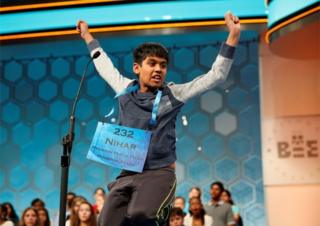Why do Indian-Americans win spelling bee contests?
The 2016 Scripps National Spelling Bee in the US was won last week by two boys of Indian origin – Nihar Janga, 11, from Texas, and Jairam Hathwar, 13, from New York.
The pair battled for 25 rounds in the final of the national competition, which was broadcast live on TV. They were declared joint winners and took home $40,000 (£27,343) each, along with additional gifts and prizes.
The 2015 Spelling Bee had been won by Gokul Venkatachalam and Vanya Shivashankar – Vanya’s older sister Kavya won in 2009.
In 2014, the winners were Ansun Sujoe and Sriram Hathwar, older brother of this year’s winner Jairam. Other Indian origin winners: Arvind Mahankali in 2013, Snigdha Nandipati in 2012, Sukanya Roy in 2011 and Anamika Veeramani in 2010.
Extraordinary success
Looking beyond the winner’s circle: About 70 of the 285 final round competitors in this year’s bee had South Asian names.
Many of them had come up the ranks through the Metlife South Asian Spelling Bee, a community effort whose alumni include three of the winners in the last three years.
Apart from winning the last nine spelling bees in the US, Indian-American children have also won the last five National Geographic Bees ,which tests the geographic knowledge of millions of American children. From 2005, the winning rate of Indian-origin children in these two competitions has been well over 80%.
But what explains this extraordinary success by a group that makes up less than one percent of America’s school-age population?
Some research I did with my colleagues Devesh Kapur at the University of Pennsylvania and Nirvikar Singh at the University of California-Santa Cruz sheds some light on the issue.
It is helpful to begin by looking at other fields of competition for young people – in school and college – to see how Indian-American children perform there.
In academic competitions, especially those focused on math or science, Indian-American youngsters do very well – nowhere near as spectacularly as in the spelling and geography bees, but at five to 20 times the rate of their population size.
These competitions include the Siemens Science Competition, Intel Science Talent Search, Mathcounts, and US Presidential, Rhodes, Truman, Churchill, and Marshall Scholarships.
But in other fields like music and athletics, Indian-Americans either barely hold their own or are non-existent at the top level.
High education
For example, in the 2013 All-National Honor Ensemble, 45% of the musicians in orchestra and 13% in the band were Asian-Americans, but just 2 and 1%, respectively, were Indian-American.
In athletics and team sports, Indian-Americans actively participate in high school but are virtually absent at college level and in professional sports.
No one of Indian origin (with a very minor Indo-Canadian exception) has ever played in any professional sports league: American football, baseball, basketball, or ice hockey.
There is also no one in the lists of emerging talent, for example, the top 100 high school prospects in baseball.
It is possible to understand these gaps.
In music, it is likely that Indian-American parents prefer to focus on the rich musical traditions from the subcontinent (that also keep their children connected to the culture).
Outside cricket, India hardly figures in global sport; so it is hard to imagine that Indian-Americans would do much better.
There are a range of plausible reasons as to why talent in some communities gets directed toward some channels and not others, but in the case of second generation Indian-Americans, the selection of the parents who immigrated to the US is perhaps the most important factor.
Many of these parents have extremely high levels of educational attainment themselves – over a third have postgraduate degrees and another one-third have college degrees.
About 90% of their degrees are in technical fields, the vast majority in engineering.
These high concentrations are also seen in what first generation Indian parents do for a living.
Close to a third work in information technology and computer-related occupations.
Several Indian-American entrepreneurs are in the same fields, but many more own and run gas stations and fast food franchises, or are in the business of hotels and motels, an industry that they dominate.
So, the parents of these high-achieving youngsters are highly educated and value education.
There are suggestions that they are particularly adept at rote learning and memorisation. They work in clusters and use ethnic and family networks to dominate a few professions.
These properties are strikingly similar to what works for their children in the spelling and geography bees – education, memorisation, and networks.
Perhaps most important are the values that are transmitted to the second generation.
The immigrant’s hunger for success, as individuals and as a community. The drive to work hard and suffer deprivations when needed. Anything that must be done to be both part of the mainstream and a shining example in it.
Sanjoy Chakravorty teaches at Temple University in Philadelphia. He is the author of five books, most recently his first novel The Promoter.
Source: Read Full Article



